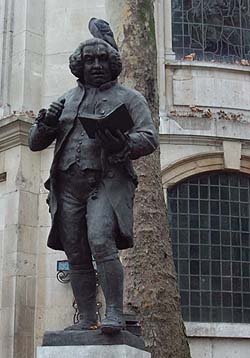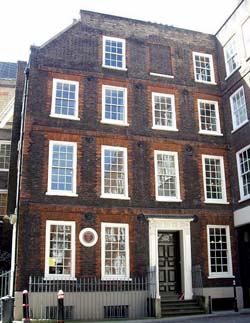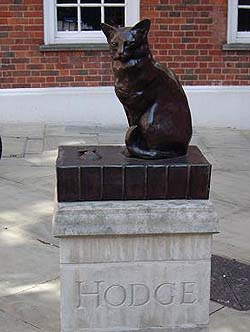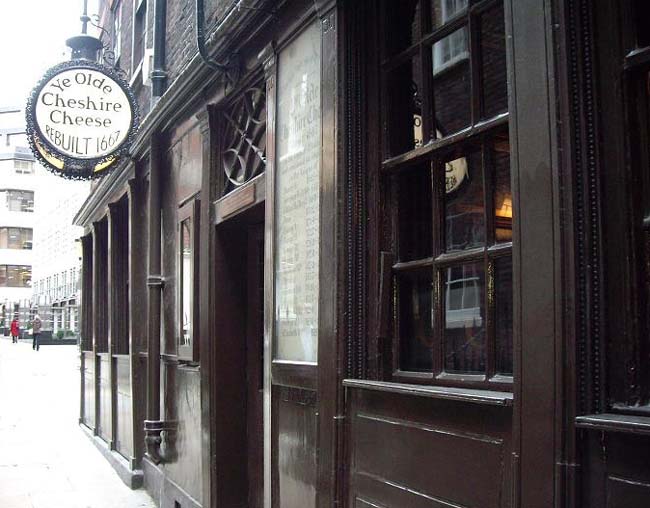"All That Life Can Afford":
The London of Samuel Johnson
by Sean McLachlan
 As it entered the 18th century, London was at the start
of its golden age. In the previous two centuries England had
burgeoned from an island kingdom to a worldwide empire, and the
wealth of its colonies poured through London, which was both its
capital and largest port. The city transformed from a cramped,
rather primitive town into a booming metropolis with wide
avenues, attractive squares, and a wealth of galleries,
bookshops, and museums. London seemed to have the best of
everything, being a major center for art and culture and having
the largest publishing industry in the world. As it entered the 18th century, London was at the start
of its golden age. In the previous two centuries England had
burgeoned from an island kingdom to a worldwide empire, and the
wealth of its colonies poured through London, which was both its
capital and largest port. The city transformed from a cramped,
rather primitive town into a booming metropolis with wide
avenues, attractive squares, and a wealth of galleries,
bookshops, and museums. London seemed to have the best of
everything, being a major center for art and culture and having
the largest publishing industry in the world.
There were plenty of ramshackle, poor neighborhoods left,
however, and the streets were filled with criminals and beggars.
The city government was corrupt and inefficient, sanitation bad,
riots common, and disease and drunkenness rife. London offered
the best and worst of life. It was, in sum, the perfect place for
a writer. One of the most famous writers from this era
was Samuel Johnson, a prolific author of articles and
commentaries on just about everything. His most famous work was
the first comprehensive dictionary of the English language. There
had been dictionaries before, but his was far more complete and
contained derivations of words. His work became a model for later
lexicographers.
Strangely, Johnson is actually better known not for his writings,
but for his biography, published by James Boswell in 1791. A
classic of the genre, it's filled with fascinating details about
the man and his times and reveals him to be as clever and
engaging in conversation as he was on paper. Johnson had an
uncanny ability to shoot off a one-liner for every conceivable
situation. On the vast differences between rich and poor in
London, he commented, "A decent provision for the poor, is
the only true test of civilization." On politics he quipped,
"Politicks are now nothing more than means of rising in the
world. With this sole view do men engage in politicks, and their
whole conduct proceeds upon it." This sort of cynicism,
which pervades his commentaries on Parliament, earned him no
shortage of critics, but he philosophized, "I would rather
be attacked than unnoticed. For the worst thing you can do to an
author is to be silent as to his words." Perhaps
his most famous quote, and certainly the one reproduced the most
in his city is: "Why, Sir, you find no man, at all
intellectual, who is willing to leave London. No, Sir, when a man
is tired of London, he is tired of life; for there is in London
all that life can afford."
He also offered a piece of good advice to travelers to this
fascinating city:
Sir, if you wish to have a just notion of the
magnitude of this city, you must not be satisfied with seeing its
great streets and squares, but must survey the innumerable little
lanes and courts. It is not in the showy evolutions of buildings,
but in the multiplicity of human habitations which are crowded
together, that the wonderful immensity of London consists.
 One of these
"innumerable little lanes" is Wine Office Court, just
off the old publishing center of Fleet St. Pass up this alley and
you'll end up in Gough Square, where Dr. Johnson lived at number
17. It's a perfectly preserved Georgian courtyard and the house,
built in 1700, is now a museum, providing a good idea of how a
reasonably well-to-do gentleman lived in those times. One of these
"innumerable little lanes" is Wine Office Court, just
off the old publishing center of Fleet St. Pass up this alley and
you'll end up in Gough Square, where Dr. Johnson lived at number
17. It's a perfectly preserved Georgian courtyard and the house,
built in 1700, is now a museum, providing a good idea of how a
reasonably well-to-do gentleman lived in those times.
While most often associated with London, the city that he loved,
Johnson was actually born in Lichfield, Staffordshire, in 1709.
Johnson decided to make his fortune in London as a journalist and
found work with The Gentleman's Magazine, a leading
periodical. He soon became popular for his sharp wit and
perceptive prose. One of his duties was to report on the
proceedings of Parliament, much like Charles Dickens' first
writing job a century later. When the government banned such
coverage, Johnson continued his column under the title
"Debates of the Senate of Magna Lilliputia", using
invented dialog and names, but showing the real people and
positions all too clearly. Later, a group of booksellers pooled
together to have Johnson write a dictionary of the language he
could use so skillfully.
Johnson decided his current quarters were too small and the
six assistants he hired for the dictionary project, so he moved
to 17 Gough Square in 1748. It was here that Boswell met Johnson
and wrote his biography, and reading this book, or at least a
portion of it, is highly recommended before visiting. Boswell
vividly describes a house filled with productive chaos, books
everywhere, Johnson hunched over piles of manuscripts, visitors
coming and going, and frequent breaks to go around the corner for
a drink at Johnson's favorite pub, Ye Cheshire Cheese.
The house has been lovingly restored by Johnson's modern admirers
and is furnished according to the period, although not nearly
with as much furniture as would have been when it was in use.
Johnson's hectic life, with servants, writing assistants, and
guests would have made his home quote crowded. Displays discuss
Johnson's career and that of his many famous friends, and there
are various mementoes from his life.
 An eloquent indication of 18th-century life in a
big city is the massively fortified front door. The thick wooden
portal is equipped with two heavy bolts and the fanlight is
blocked with a spiked bar to stop the common practice of burglars
employing young boys to crawl through and open the door from the
inside. As added protection, there is a heavy chain fasted to a
corkscrew latch. A skilled burglar could pull a chain off a
normal latch with a hook on the end of a string thrown through
the fanlight, but it wouldn't have been able to unwind it from
the corkscrew. An eloquent indication of 18th-century life in a
big city is the massively fortified front door. The thick wooden
portal is equipped with two heavy bolts and the fanlight is
blocked with a spiked bar to stop the common practice of burglars
employing young boys to crawl through and open the door from the
inside. As added protection, there is a heavy chain fasted to a
corkscrew latch. A skilled burglar could pull a chain off a
normal latch with a hook on the end of a string thrown through
the fanlight, but it wouldn't have been able to unwind it from
the corkscrew.
The garret is where Johnson and his assistants worked, and here
the displays cover the writer's most famous project. There's a
copy of his dictionary to flip through that makes fascinating
reading. The definitions often come with a bit of editorializing,
such as: "LexicographerĐa writer of dictionaries; a harmless
drudge, that busies himself in tracing the original, and
detailing the signification of words."
In the courtyard out front is a statue to Hodge, "a very
fine cat indeed". The fact that there's a statue to
Johnson's cat says a lot about English character. Johnson used to
go out and buy Hodge oysters, not trusting the servants to keep
Hodge as sufficiently well fed as such a fine cat is
entitled.
Sadly, the atmosphere of Gough Square is being disturbed by a
massive building project just to the north. Towering office and
apartment blocs already loom over the square, and while their
completion will finally end the relentless staccato of
jackhammers, visitors will still have to shade their eyes to
screen out this modern intrusion on Georgian London.
Once you're done with the house, get a drink at Ye Olde Cheshire
Cheese, named simply Ye Cheshire Cheese in Johnson's era. It's
not clear when a pub was first built here, but the current
building dates to 1667, having been erected on the site of an
older pub destroyed by the Great Fire of London. Come here to see
the way pubs used to be: a rambling layout with tiny little
rooms, dim lighting, and great beer. Boswell drank with Johnson
here as he worked on Johnson's biography, and many of the good
doctor's witticism were probably said here after a pint or three.
Dickens and Chesterton drank under these beams too, as does the
struggling and soon-to-be-famous novelist Sean McLachlan when
he's in town. The crowd is a mixture of tourists and City lawyers
(called barristers in England), but despite this well-heeled
clientele it's one of the cheaper pubs in town. Johnson's
favorite bench is preserved in the dining room, as is one of the
chairs from his house, and there's a painting of him in one of
the front drinking rooms.
The square, the house, and the pub add up to a fine taste of
Georgian London, so head on over to the good doctor's house, say
hello to Hodge, and quaff a pint where men of letters have
quaffed for generations.

More Information:
Dr. Johnson's House is located at 17 Gough Sq. EC4 and is open
Mon.-Sat. 11 a.m.-5:30 p.m. May-Sept.; 11 a.m.-5 p.m. Oct.-April.
Entry is £4.50 for adults, £3.50 for seniors and
students, £1.50 for children, and £10 for a family.
The closest Tube station is Blackfriars and their phone number is
020-7353-3745. More information can be found on their website at
http://www.drjohnsonshouse.org
Ye Olde Cheshire Cheese is located at 145 Fleet St. EC4 and is
open Mon.-Sat. 11 a.m.-11 p.m., Sun. noon-10:30 p.m. The nearest
Tube station is Blackfriars and their phone number is
020-7353-6170. It's right off Fleet St. down an alley called Wine
Office Court.
More Information:
We regret that we no longer have the resources to maintain up-to-date links and/or hours and pricing details for the various sites and attractions listed on this website. For more information about the location(s) listed above, please use your favorite search engine or visit Wikipedia.
Article and photos © 2007 Sean McLachlan
|
